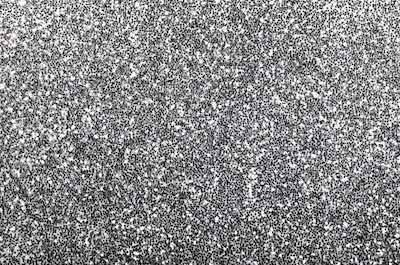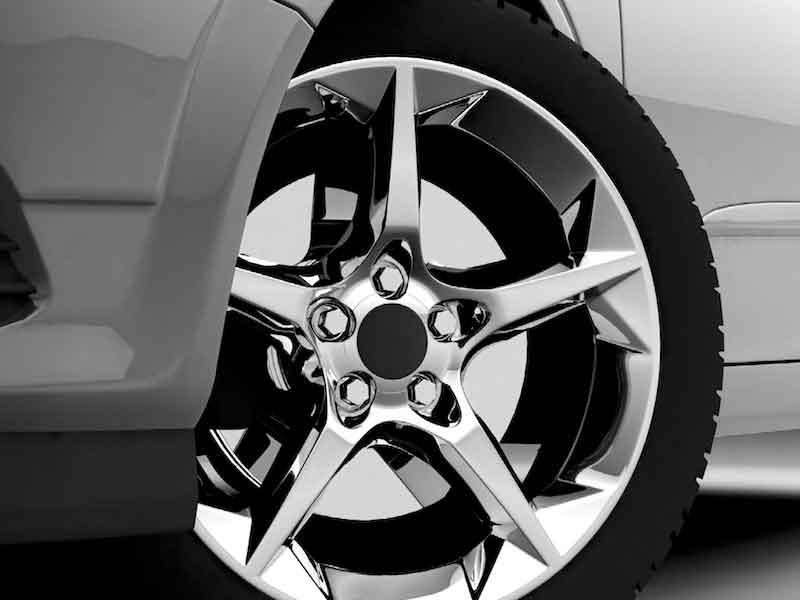Metallics are powder coatings that have a metallic or sparkle effect added to them.
 Fiona Levin-SmithThese metallic pigments are usually aluminum flake or mica and can be of different colors and sizes. There are those that will be very obviously sparkly or glittery, others shimmery, and some will have more subtle sparkle effects. So, for this guide, we should specify that we aren’t talking about coatings that give the appearance of metal - what we are talking about are metallic coatings that have a sparkling effect.
Fiona Levin-SmithThese metallic pigments are usually aluminum flake or mica and can be of different colors and sizes. There are those that will be very obviously sparkly or glittery, others shimmery, and some will have more subtle sparkle effects. So, for this guide, we should specify that we aren’t talking about coatings that give the appearance of metal - what we are talking about are metallic coatings that have a sparkling effect.
Now, there are two basic types of metallic: bonded and unbonded. Both metallics are capable of a sparkling effect. Where they differ is in how they are made.
Bonded
Bonded metallics are coatings in which the effect pigments (the metallic or mica flakes) adhere to the powder coating particles. Doing this creates a more consistent application, as opposed to dry blend/unbonded, and enables a much better performance once reclaimed.
How are bonded metallics achieved, you may ask? Well, a bonded metallic coating is made by heating the powder coating until the outside is slightly sticky. The metallic pigments are then added and will adhere to the powder coating particles. Voila!
At IFS Coatings, we also have a special process when bonding AAMA 2605 coatings to ensure that we do not damage the integrity of the treatment on the aluminum flakes.
Advantages: Any powder metallic offers a truly unique appearance to the part. Generally, it is easier to apply bonded metallics than unbonded, as the spray dispersion is much smoother than unbonded metallics. This results in a smoother application and a cleaner and more consistent finish.
Disadvantages: Due to the extra processes bonded metallics are run through, they are typically more expensive than unbonded metallics. In the long run, though, bonded metallics might well be worth the extra cost.
There is also the issue that you cannot purchase a small amount of bonded metallics. Due to the machines and processes that bond the metallic to the pigment, it just is not feasible to make a batch any smaller than a certain size.
Unbonded
As you may guess from the name, unbonded metallics are powders that have not been put through the bonding process. Rather than that, the metallic flake and the powder are put into what is, essentially, a blender. That is whizzed around and boxed up. It is a simpler, speedier, and cheaper process as opposed to what is used to create bonded metallics. While that may sound ideal, let’s go through the advantages and disadvantages first.
Advantages: As unbonded metallics are not put through a bonding process, they can be purchased in smaller batches than bonded metallics. Because of this, it is also much cheaper than bonded metallics, and your order can often be shipped out to you much quicker. However, it does have its downsides.
 Disadvantages: Unbonded metallics require more attention to detail when in use, such as when spraying the substrate or cleaning equipment. As the metallic and powder particles have not been bonded together, it can be far more difficult to get a smooth and consistently metallic coat. The sparkles can pull to the edges or disperse unevenly on the coated part.
Disadvantages: Unbonded metallics require more attention to detail when in use, such as when spraying the substrate or cleaning equipment. As the metallic and powder particles have not been bonded together, it can be far more difficult to get a smooth and consistently metallic coat. The sparkles can pull to the edges or disperse unevenly on the coated part.
When spraying metallics, we recommend feeding the spray out of a fluidizing hopper - avoiding box feeders if you can. Taking this step will assist in increasing the evenness of the flow as you spray, ensuring that your gun is being fed a rolling mixture of the powder. Otherwise – and especially with unbonded metallics – you might get clumps of pigment and metallic flakes. This creates an uneven coat and is not an attractive final product.
Encapsulated Metallic Particles
Often, and especially in the architectural world, the question of ‘why doesn’t this metallic powder coat require a clear coat for protection?’ is asked. In short – particularly with our powders that meet and exceed the requirements of the AAMA specifications – we use encapsulated metallic pigments. These are metallics that have been made using metallic flakes that have been through an extra treatment process. This process creates a metallic powder that can be applied to a substrate and does not require a clear coat.
At IFS Coatings, all of the metallics that we use in our coatings are encapsulated to some degree. The aluminum pigments that we use for general applications have a basic encapsulation that assists in weathering and chemical resistance. The pigments that we use for AAMA coatings have a complete encapsulation that allows for significantly better weathering and chemical resistance.
Keep in mind that metallic powders with more complete encapsulated metallic flakes are more expensive.
So, now we’ve covered bonded vs. unbonded, let’s discuss what’s involved in creating a great metallic look.
The Look: Where metallics differ from other coatings, really, is how they look on the final product. Typically, metallics have a sparkling finish unless your job shop is trying to mimic an anodized finish. Solids are just that: a solid color. IFS Coatings has a range of metallics, including standard metallics, like Silver Sparkle and Gold Nugget, chrome effects, like New X Chrome, and anodized colors that use metallic, like Dark Bronze. There are also translucent with a sparkle to them, such as Starbrite Copper and Translucent Red.
The Pricing: As for pricing, metallics are more expensive than solids, especially if you are using a bonded metallic. This is because of the extra processes involved in actually creating a bonded metallic powder. Plus, some metallics require a clear topcoat, and others require a base coat. Even if the particular metallic you are using only needs one of those requirements, it is an extra step in the manufacturing process and therefore cost added to a job.
Storage: Storage of metallics is very similar to how you store any other powder coating. Keeping the temperature 80 degrees or below, with between 40% and 60% relative humidity, is ideal. At IFS
For coatings, for most powders, the golden temperature is 75 degrees Fahrenheit. Asides from temperature, metallic can be stored in the same way as solid powders – air-tight containers that keep contaminants out. Depending on the size of your job shop, bear in mind you may also need to store the power in smaller quantities.
Minimum Quantity and Lead Time
There is always a lead time for custom powder jobs, but where solids and unbonded metallics have a 7-10 day custom lead time, bonded metallics are usually more like a three-week lead time. This is because the process of making a metallic one requires more steps than making a solid powder. First, the base is made, and then it is moved through a bonding process.
Because of this extra process for bonded metallics, the minimum order size is also larger – around 220lbs. Why is such a limit placed on an order? Well, simply put, the machines we use to bond the metallic particles to the powder require a certain amount of product for them to work. Keep in mind that this is for custom orders, though. Stocked metallics can be bought in much smaller quantities. So a great tip that many people use is, if there is a highly popular metallic at your job shop, then think about buying it in bulk.
So, Who Can Spray Metallics? The good news is any job shop can use metallics. In the past five years, the amount and number of metallics that we can make have broadened. So the variety of special effects that job shops can now offer customers, outside of solid colors, has grown wildly. Metallics are so eye-catching it’s a great way to promote your capabilities as a job shop!
About the Actual Spraying Process
Metallics can be more difficult to spray than solid color powders. Essentially, electrostatics, among other things, have an effect on the way the metallic flakes in the powder orient. A small change in flake orientation can change the color of the coating, especially when there is a large contrast between the base color and the color of the metallic flake.
And then there is the equipment. Most of the new equipment these days has factory settings, which often include a metallic setting. Whether or not these settings actually work well can be a bit of a toss-up. Sometimes they do the job, and sometimes they don’t, and you have to adjust the settings yourself.
Regardless, for most metallic applications, you may find that you’ll have great success if you turn down your kVs and your microamps. A good range is between 60 and 75, with the microamps between 25 to 35.
KV’s, microamps, gun-to-substrate distance, good grounding, and gun speed can all affect how the final product looks on the substrate and how smoothly it applies. Ramp your kV’s too high, and the metal flakes will not lay right on the substrate, giving a grainy texture to the surface. Apply the powder too fast, and you can waste a lot of product. This is why metallics are somewhat trickier to apply than standard powder coatings; there is a lot that can go wrong. However, overcoming most of this just comes down to experience. The more you use metallics, the better you will become at applying them – with fewer rejects as the in’s and out’s become second nature to you.
How to Spray Metallics
 A new or old hat at spraying powders, metallics are different enough that they require just a little more attention to detail. We have put together a guide of useful steps that will help you either sharpen or create a process for your job shop.
A new or old hat at spraying powders, metallics are different enough that they require just a little more attention to detail. We have put together a guide of useful steps that will help you either sharpen or create a process for your job shop.
- First: Ensure that you have a properly prepared substrate. It must be cleaned thoroughly and consistently. You likely already know the pitfalls of curing a coating over an improperly pretreated substrate. And the results? Not good. Whether you shot blast or treat with caustic cleaners, make sure that you have done a thorough job. If you are not applying some sort of base coat, then ensure that your substrate is free of marks and stains, as well as contaminants. Metallics do not act like concealer, so dark spots, streaks, and stains will likely show through - even through a thicker coat.
- Second: Make certain that you have good earthen ground. So, ensure that the racks and hooks have good ground and metal-to-metal contact.
- Third: Fluidize the metallic well, but not to the point of geysers blowing. Steadily boiling soup is the consistency that you want, with little bubbles of air disturbing the surface.
- Fourth: Check that your equipment is cleaned properly of all contaminants, especially if you are spraying a black or a pale metallic.
- We would even suggest having dedicated fluidizing hoppers and hoses for metallics. If your job shop sprays a lot of metallics, having a dedicated set of equipment for them is a good investment.
- Fifth: The newer powder coating equipment sometimes has a factory setting for metallic. If your equipment has a factory metallic setting, this will be a good starting point for their application. Otherwise, start with settings between 60kVs and 75kVs to 40 microamps. Now, you have your electrostatics good to go.
- Sixth: Check those pressure settings. You want a good, even spray during the application process. That means pressure, but also the distance between the gun and the substrate. With more complicated substrates, this can be tricky, especially if it has any deep recesses. Use your judgment, adjust the settings as you need to keep the gun steady, and you will be fine.
- Seventh: Before curing anything, check whether or not the powder you are using requires a clear coat – especially if it is going to be exposed to the elements. Some metallics are formulated using encapsulated metallics so that they do not need a topcoat of any kind. Other metallics will need a clear topcoat, and if so, be careful not to over-cure the metallic base coat before applying the clear topcoat. This will help to avoid inter-coat adhesion issues. Follow the guidelines on your supplier’s products, and be aware that not all products, like base and top coats, are formulated the same. Some will work together, and some will not. Be sure to use products designed to work together.
- Eighth: Once you have an even coating on the substrate, it is curing time. Pay close attention to the manufacturer’s temperature and cure time directions. As an example, if the instructions say to cure for ten minutes at 400 degrees, it means ten minutes once the part has reached 400 degrees. The cure time does not include pre-heating the oven or waiting for the part to reach that temperature. Larger ovens and larger parts especially can take some time to warm up to the required temperature.
- Eight-ish: If needed, apply the clear topcoat evenly. Ensure that you have good earthen ground, and this will help keep back ionization down. Be aware of your gun-to-part distance. Apply a clear coat too thick, and it can take on a milky or yellow tinge. Once again, check the manufacturer’s specifications, but a general rule of thumb is to keep it between 1.5 to 2 mills in thickness.
- Nine: Cure for the final time, and you are done. If the metallic does not need a topcoat, do not feel like you should lay one down anyway. Applying and curing another coat adds time and cost to a job and increases the chances of having a reject.
Dos and Don’ts
Do use rinse air if your guns are equipped with that feature. Otherwise, the metallic will build upon the end of the gun until it suddenly releases. And then you will have a big, metallic splotch on the substrate. Not an ideal outcome, right? So, keep an eye on the nozzle of your gun and turn up the rinse air setting so that it stays clean.
Do not spray and pray. Have sample panels using different types of substrate and different products for both you and your customers. This way, you will work out the kinks in your process – or with a new product, if you are unfamiliar with it – and know exactly what the finished product will look like.
Do keep your gun-to-surface distance in mind. We said it before, but it bears repeating. It is an important step to remember!
Do not be heavy-handed with clear coats. Asides from what we said earlier, clear coats can also subtract from the vibrancy of metallics. Using a high-gloss clear coat is a good way to get around this issue. Avoid low gloss coats; they can diminish the brightness of the sparkle further.
Do be sure to always fluidize your powders during the application process. This is doubly important for unbonded metallics, as if you do not fluidize properly, you will get ugly lumps of resin, pigment, and metallic flakes shooting out of your gun.
Do be aware that if you are applying your metallic as part of a two-coat process – perhaps a chrome look – the metallics will look different sprayed over different colors. If you spray a chrome metallic over a black base, the final look will appear very different as opposed to a chrome metallic sprayed over a white base. Have multiple sample panels and play with different combinations so that you know what it will look like.
To Polish It Off
Metallics are a great way to add special effects, from soft glitters to bright sparkles to a coating. They come in a wide range, from chrome effects to bright, silver sparkles, and can be purchased either bonded or unbonded. Bonded has the advantage of being easier to apply and ensuring a beautiful, consistent, and even finish, while unbonded is cheaper and can be bought in smaller quantities. Both have their disadvantages, too, with bonded being quite pricey and unbonded tricky to apply smoothly. With practice, spraying metallics gets easier, and these beautiful metallic effects offer job shops a fantastic spectrum of coatings for their customers.
Bear in mind: if your customer is used to liquid metallic, there can be some differences. The maximum metallic loading in a powder is significantly less than the metallic loading of a liquid. While exact numbers depend on the particular pigment, a general rule is that small flakes, for example, those used to make a sheen or anodized silver, have a maximum loading of around 5% and a large sparkle flake can go upwards of 10% maximum loading. This differs from liquid paints, which can have a metallic loading of around 20%. If you push too much of the metallic flake into the powder, you can get all sorts of problems - application issues, dry spray, and issues with powder sloughing right off the substrate.
Final Top Tips
-
If a customer wants or requires a metallic with a clear topcoat, consider showing them a sample of what the final product will look like; this includes a panel with a base coat and a clear coat. By doing this, you can avoid potential headaches by simply showing the customer exactly how the finish will appear.
-
Metallic colors can change slightly depending on variations in film thickness. Keep a sharp eye on the substrate during the application process, and carefully evaluate the coating before curing it to ensure even consistent pigmentation.
-
With certain metallics, like mica, the angle and lighting can alter their appearance. When laying out the details of a job, ask the customer how each surface will sit and what angle will it rest at, and advise that there will be variations in how the metallic effect appears depending on the lighting. Sample panels can really help you out here to show the customer exactly what you mean.
-
Metallic flakes come in different sizes, and occasionally, smaller metallics can be a slight problem. During the spray process, there can be issues with the flakes sticking to the end of the gun. Keep a sharp eye out for this, and stop and clean the gun when needed.
For further questions or inquiries, drop us a line at coatingsinfo@ifscoatings.com
Fiona Levin-Smith is Vice president of Marketing and Specification for IFS Coatings. For further questions or inquiries, visit www.ifscoatings.com



































